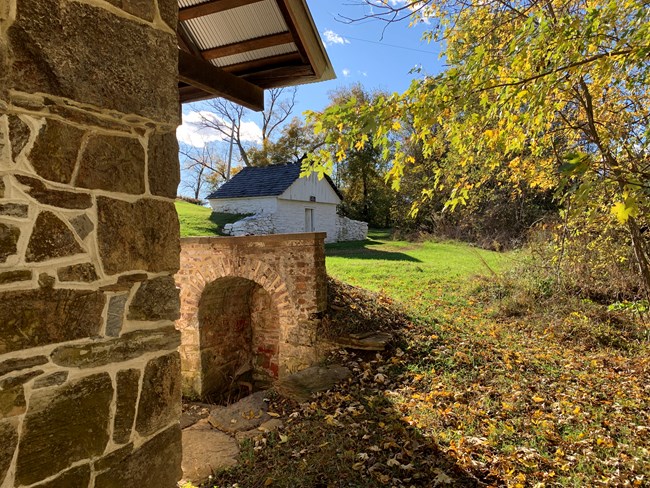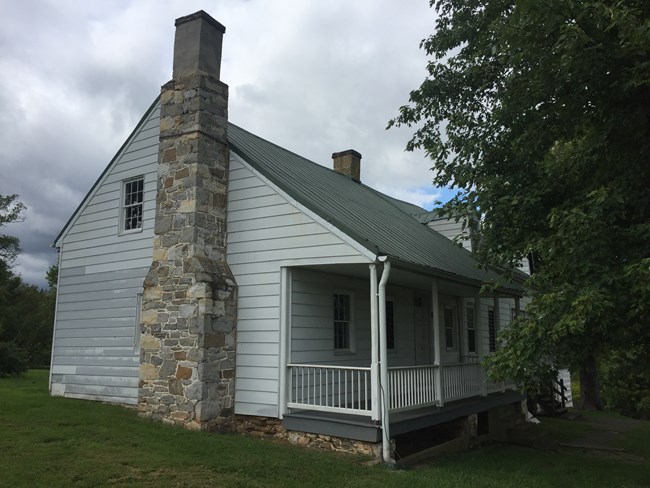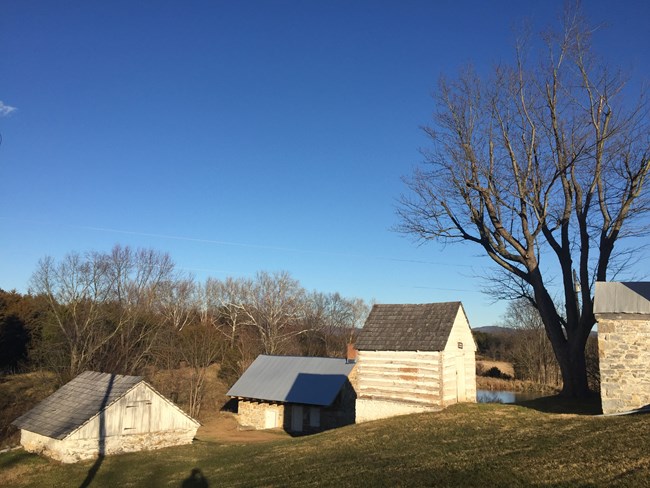
NPS Antietam / B.Baracz The Roulette Family and FarmAt the time of the Civil War, William and Margaret Roulette and their children lived on a large, productive farm outside the small town of Sharpsburg. However, by the end of September 1862, that farm had become the backdrop for a significant part of the action of the bloodiest single-day battle in American history. Today, their house and some of their outbuildings stand as silent witnesses to the carnage.Historical Ownership and Structural ChangesThe original owners of what we now know as the Roulette property are unfortunately unknown as are the names of those who built the first house on the site. We do know that as early as 1739, William Anderson lived here and farmed a tract called Anderson’s Delight. John Reynolds, who purchased the property in 1761, probably began construction of the oldest part of the house that exists today, which dates to the mid-1700s, and was originally constructed as a two-room cabin; this is the southern part of the house today. Around 1780, the center section was added. Around 1800, a kitchen was added to the north end, which included a beehive oven. Finally, a bathroom was added on in the 20th century.Reynolds and his descendants owned the farm until 1804 when John Miller bought the farm. His descendants would grow crops and raise livestock on the property for the next eighty years. Included in this list of descendants was Margaret Ann Miller, whose husband, William Roulette bought the property before the Civil War. The Roulettes had been in Washington County since before 1780, and William Roulette grew up on a different farm in the local area. William and Margaret were married in 1847 and had their first child in 1849. 
NPS Antietam / B.Baracz “Drive ‘Em:” The Battle of AntietamBy Tuesday, September 16th, having heard the sounds of battle coming from South Mountain as early as September 14th, William Roulette took his family, including his six children who ranged in age from 1 to 14 years old, to the Manor Church, a Brethren church located six miles north of the battlefield. However, the farm couldn’t be left alone indefinitely, so William returned on September 17:Mr. Roulette had removed himself to a safe place in season, but returning himself to look after his stock he was held in limbo by the rebs. When firing began he went into the cellar for safety, but when our boys cleaned out the Johnnies he quickly ran out, shouting excitedly: ‘Give it to ‘em!’ ‘Drive ‘em!’—'Take anything on my place only drive ‘em! Drive ‘em!’ Then he started for the rear, for he wasn’t singing just then “there’s no place like home. Also living on the farm at the time of the battle were Nancy Camel, a former slave who was working as a domestic servant, and Robert Simon, a 15-year old African American man who was working as a hired farm hand. Camel had been born into slavery October 13, 1813. On June 14, 1859, Andrew Miller of Tilghmanton manumitted Camel. She likely lived in a small room above the kitchen. Her responsibilities probably included gardening, caring for the children, cooking, and cleaning. She was a member of the Brethren church and is buried in the cemetery at the Manor Church north of the battlefield. There was also a tenant farmer’s house along the Roulette farm lane, which Hiram Osborne Clip or Clipp, a Virginian who had briefly been a Confederate soldier before leaving the army and moving to Maryland, lived in while he leased part of the Roulette farm. Archeological evidence suggests that the Clipp house was built around 1820; by 1900 it had been razed. Though the house was largely in its present state by the time the Roulettes moved in, William Roulette probably added the large bank barn to sustain his farming operation. The family kept horses, cows, sheep, and pigs on their property and grew corn, wheat, oats, and rye. The farm also contained an orchard, a vegetable garden, and several beehives. These hives would create particular chaos for a rookie regiment advancing toward the Sunken Road around 10:00 am on September 17th. As a Confederate shell exploded among the 132nd PA, the men broke, knocking over the hives. As George Lovettt, Company A, 132nd PA described it in his dedication speech for the regiment’s monument at Antietam in 1904: In the line of advance by Kimball to attain this point [the Sunken Road], his forces had to pass through the garden and yard of a residence known as the “Roulette House” and in going through this place on a double quick several bee hives were upset, which caused some disorder and confusion amongst the men, especially the line of the One-Hundred and Thirty-Second Pennsylvania Volunteers, but the confusion caused by this accident of bees was soon straightened out by the action of the Brigade Commander, Field and Staff of the One-Hundred and Thirty-Second. 
NPS Antietam / B.Baracz Death and Devastation: AftermathMany wounded Union soldiers were taken back to the Roulette barn, and later ambulances would pick up those who needed to be transported at the intersection of the Roulette farm lane and the Sunken Road. After the fighting had ceased, Union soldiers who held the field began the grim task of burying the dead. Roulette reported that 700 soldiers were buried on his property alone.Despite filing claims with the federal government for damages to his property totaling more than $3,500, William Roulette received no compensation for his home and outbuildings, though he did receive a payment of $371 for a hospital claim. The financial impact of the battle was nothing compared to the personal loss that the Roulettes suffered. As a result of typhoid fever, likely caused by the unsanitary conditions of so many soldiers camping nearby, the Roulette’s youngest daughter, Carrie May, who was only twenty months old, died on October 21, 1862. Some of the most famous photographs that Alexander Gardner and James Gibson, photographers employed by Matthew Brady, took during their time at Antietam were taken close to where the Roulette Farm Lane intersects the Sunken Road. This series of photos was the first time in the United States that war dead had been photographed before they were buried. To learn more about photography at Antietam visit this page. Reunion and PreservationOn September 16-17, 1891 veterans of the 14th Connecticut returned to Antietam to tour the grounds. They had difficulty securing accommodations in the small village for so many people—upwards of 300. Ultimately, the Chairman, Secretary, and their wives stayed at the Roulette house, “a spot having great attraction to us not only because of its relation to our first battle experience but as Edenic in its kind.”The farm remained in the Roulette family until 1956. In 1998, the Richard King Mellon Foundation purchased the farm and donated it to Antietam National Battlefield. Today, the Roulette farm helps us to picture the landscape that Union troops advanced through toward the Sunken Road and to understand the depth of suffering that followed in the wake of the twelve-hour battle. The house and farm stand as a symbol of not only bravery, but also perseverance and resilience in the face of trauma. 
NPS Antietam / K.Snyder |
Last updated: September 15, 2023
